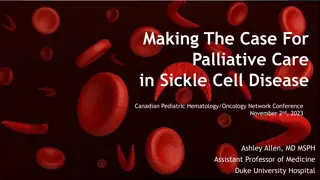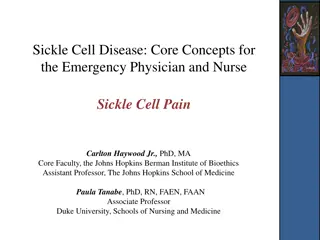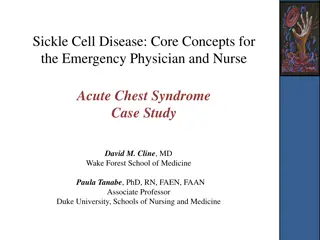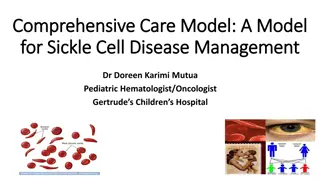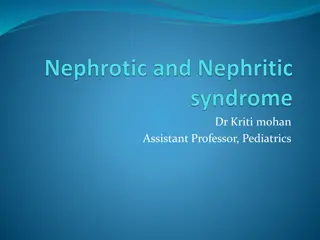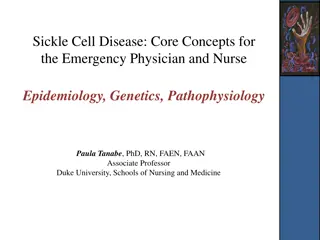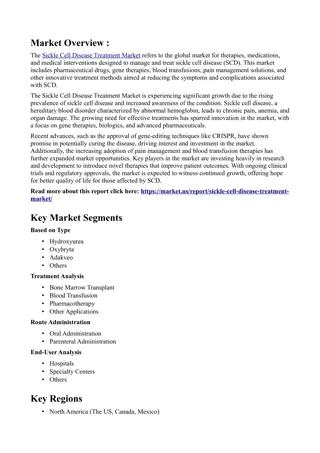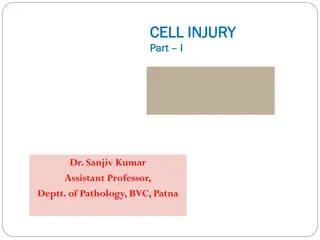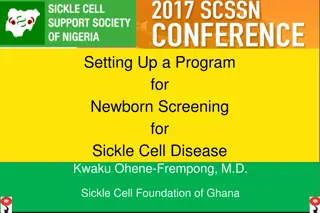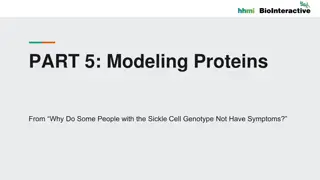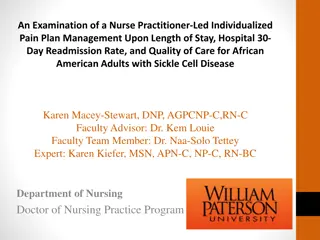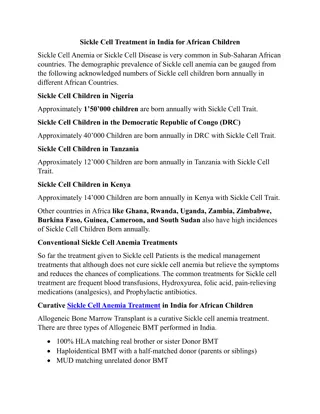Can You Tell It's Sickle Cell? Comms Toolkit
A campaign by NHS England and NHS Improvement to raise awareness of the signs and symptoms of Sickle Cell crisis among urgent emergency care staff and individuals living with the condition. The campaign also promotes uptake of an e-learning module on Sickle Cell and healthcare inequalities.
1 views • 17 slides
Vi-CELL.BLU - Advanced Cell Counting Instrument
Vi-CELL.BLU is a cutting-edge cell counting instrument that offers faster analysis, increased resolution, and improved optical sensor technology for enhanced cell concentration and viability assessments. The device features a user-friendly interface, Trypan blue method for live cell detection, and a
1 views • 19 slides
Palliative Care in Sickle Cell Disease: Enhancing Quality of Life
Explore the importance of palliative care in sickle cell disease, focusing on biopsychosocial factors and quality of life impacts. Review literature related to palliative care, advance care planning, and end-of-life care in SCD. Learn about potential roles for palliative care involvement to enhance
4 views • 41 slides
Medicaid and CHIP Coverage of New Treatments for Sickle Cell Disease
This communication highlights the Medicaid and Children's Health Insurance Program (CHIP) coverage of new treatments for Sickle Cell Disease (SCD), focusing on the approval of milestone gene therapies, Casgevy and Lyfgenia. It discusses the commitment of CMS to improving healthcare access, quality,
2 views • 13 slides
Understanding Sickle Cell Disease Pain Management
Sickle cell disease (SCD) patients often experience vaso-occlusive crises (VOC) causing acute pain, a hallmark symptom of the disease. Pain management is crucial in healthcare interactions for these patients, with chronic pain also being a significant concern due to organ/tissue damage. Research sho
1 views • 18 slides
Understanding Cell Viability Assays in Laboratory Testing
Cell viability assays play a crucial role in determining the health and status of cells, measuring their ability to survive and proliferate. These assays involve various techniques such as dye exclusion, colorimetric, fluorometric, luminometric, and flow cytometric assays. By assessing factors like
6 views • 16 slides
Managing Acute Chest Syndrome in Sickle Cell Disease
A case study of a 31-year-old male with sickle cell disease presenting in the emergency department with a pain crisis. The patient has a history of avascular necrosis, priapism, NSTEMI, cholecystectomy, and previous acute chest syndrome. Explore the patient's symptoms, past medical history, and reco
7 views • 19 slides
Advancements in Regenerative Medicine for Sickle Cell Anemia
Regenerative medicine holds promise for treating sickle cell anemia through techniques like stem cell transplantation. This approach targets genetic blood diseases, offering potential cures beyond traditional uses like eradicating cancer. Despite obstacles like toxicity and donor availability, innov
8 views • 26 slides
Understanding Sickle Cell Trait in Intercollegiate Athletics
Sickle cell trait is a hereditary condition affecting red blood cells' shape and oxygen-carrying capacity. Individuals with this trait can experience complications during intense exercise, leading to health risks in athletics. This article explores the impact of sickle cell trait on athletes, the re
0 views • 15 slides
Bacterial Cell Structure and Composition Overview
Bacterial cells exhibit variations in size, typically ranging from 0.75 to 1.5 micrometers. The cell envelope, comprising glycocalyx, cell wall, and cell membrane, plays crucial roles in protection and cell function. The cell membrane, a thin barrier rich in phospholipids and proteins, is integral t
1 views • 28 slides
Overview of Cell Culture Methods and Importance in Research
Introduction to the principles of cell culture, including tissue culture, organ culture, and cell culture methods. Discusses the advantages and disadvantages of each technique and highlights the need for cell culture in research for studying cellular behavior and large-scale production of cell mater
3 views • 45 slides
Comprehensive Care Model for Sickle Cell Disease Management
Comprehensive care is crucial for managing sickle cell disease, the most common haemoglobinopathy worldwide. Despite advancements in high-income countries, challenges persist in low and medium-income nations, leading to preventable deaths, especially in Africa. A comprehensive care approach has sign
0 views • 15 slides
Understanding Nephrotic Syndrome in Pediatric Patients
Nephrotic syndrome is a significant chronic disease in children characterized by heavy proteinuria, hypoalbuminemia, edema, and hyperlipidemia. It is primarily idiopathic, with secondary causes including SLE, sickle cell disease, and infections. The pathophysiology involves glomerular dysfunction le
0 views • 43 slides
Understanding Sickle Cell Disease: Core Concepts for Healthcare Professionals
Sickle Cell Disease (SCD) is a genetic disorder primarily affecting individuals of African descent but also found in other ethnic groups. The most severe form is sickle cell anemia (SS), presenting with life-threatening complications. This article explores the epidemiology, genotypes, and changes in
0 views • 18 slides
Community Specialist Nursing Care for Sickle Cell & Thalassaemia Patients
Promoting understanding of health & social challenges faced by individuals living with sickle cell disease and thalassaemia major. Discusses referral & care pathways, role of specialist nurses, and resources for primary care support. Emphasizes the importance of managing psychological impact, stigma
0 views • 12 slides
Regulation of the Cell Cycle: A Comprehensive Overview
Variation in cell cycle length in humans, controlled by internal and external mechanisms, with special proteins and checkpoint systems ensuring proper progression. External events trigger initiation and inhibition of cell division, while internal checkpoints maintain genetic integrity and chromosome
4 views • 14 slides
Sickle Cell Disease Treatment Market
The Global Sickle Cell Disease Treatment Market size is expected to be worth around USD 6.9 Billion by 2032 from USD 1.9 Billion in 2022, growing at a CAGR of 14.10% during the forecast period from 2023 to 2032.\n\n
0 views • 3 slides
Understanding the Cell Cycle and Mitosis Process
The cell cycle consists of two main periods: Interphase and Mitosis. During Interphase, the cell prepares for division by growing in size and copying chromosomes. Mitosis, the division of the nucleus, results in the formation of two daughter cells with identical chromosome copies. Centrioles and cen
0 views • 26 slides
Understanding Cell Division: Processes and Types
Cell division is a vital process in living cells for growth and reproduction. This article explores the basics of cell division, including the cell cycle, types of cell division (such as mitosis and meiosis), and the initiation of cell division. It also covers key phases like interphase and provides
0 views • 20 slides
Overview of Cell Division in Prokaryotes and Eukaryotic Cells
Cell division plays a crucial role in the growth and reproduction of all organisms. In prokaryotic cells, binary fission is the primary mode of division, while eukaryotic cells undergo a more complex process involving cell growth, DNA replication, chromosome distribution, and cytokinesis. The cell c
0 views • 10 slides
Newborn Screening Program Challenges in Africa
Newborn screening programs, particularly for diseases like sickle cell anemia, face challenges in adoption in African countries such as Nigeria despite their proven benefits. The Yoruba people, who dominate the southwestern part of Nigeria, have a significant population, and efforts are being made t
0 views • 11 slides
Understanding Cell Injury and its Causes in Pathology
Rudolph Virchow's concept of disease starting at the cellular level is explored in this content, focusing on the impact of the external environment on cell equilibrium. The role of the plasma membrane as a barrier and the definitions of normal cell function, adaptation, reversible injury, irreversib
0 views • 16 slides
Understanding the Impact of Cold Weather on Sickle Cell Disease
Patients with sickle cell disease (SCD) often experience painful episodes known as sickle cell crises due to abnormally shaped red blood cells. The severity of SCD can be influenced by genetic and environmental factors, with cold weather being linked to increased pain episodes. Research has shown co
0 views • 27 slides
Understanding Natural Selection in Higher Biology
Natural selection in action is demonstrated through mutations that impact an organism's adaptation to changing environments. Sickle cell anemia, a genetically transmitted blood disorder, exemplifies the consequences of specific mutations. The condition manifests in various symptoms, affecting indivi
0 views • 18 slides
Explore the World of Developmental and Cell Biology
Developmental biology, stemming from embryology, investigates how organisms evolve from a zygote. It merges various fields like genetics, cell biology, and cancer biology. Cell biology focuses on cell properties and behaviors, using tools like genomics and microscopy. Research areas include cancer c
0 views • 8 slides
Understanding Sickle Cell Anemia: Causes, Symptoms, and Pathophysiology
Sickle cell anemia is an inherited disorder affecting red blood cells' shape, leading to decreased oxygen delivery and various symptoms like fatigue, pain episodes, and more. The condition arises from a genetic mutation affecting hemoglobin production. Individuals with sickle cell trait may not disp
0 views • 7 slides
Role of Cell Cycle in Nanoparticle Uptake and Dilution in Cell Population
The cell cycle plays a crucial role in the cellular uptake and dilution of nanoparticles within a cell population. This process involves different phases such as G1, S, G2, and M, each with specific functions related to cell growth, DNA synthesis, protein synthesis, and cell division. Understanding
0 views • 20 slides
Warrior Champion: Defying the Odds with Sickle Cell Disease
Childhood with Sickle Cell Disease in the British Virgin Islands during the seventies was just but a life struggle. My story is all about strength, perseverance and nothing is impossible no matter how hard life tries to make it for you. This is my st
1 views • 6 slides
Implementing Newborn Screening for Sickle Cell Disease
Establishing a program for newborn screening of sickle cell disease is crucial for early identification and intervention, reducing associated mortality and morbidity. Key principles and practices, including the importance of analytical validity and safe interventions, underscore the need for informe
0 views • 41 slides
Exploring Protein Modeling in Sickle Cell Genotype
Dive into the world of protein modeling to understand why some individuals with the sickle cell genotype remain asymptomatic. Explore amino acid sequences, build typical and sickle cell protein segments, and visually represent the changes in protein structure. Hands-on instructions guide you through
0 views • 6 slides
Exploring Cell Structure and Function in Developmental Biology
Discover the intricate world of cell structure and function in the context of developmental biology. Delve into the inner workings of organelles, their functions, and how they contribute to cellular activities. Engage in interactive activities like building cell models and playing Cell Detective to
0 views • 14 slides
Impact of Nurse Practitioner-Led Pain Management on Sickle Cell Disease Outcomes in African American Adults
Exploring the effects of individualized pain management plans led by nurse practitioners on length of stay, 30-day readmission rates, and quality of care for African American adults with sickle cell disease. The study aims to assess the potential benefits of this approach in improving healthcare out
0 views • 30 slides
Understanding Cell Cycle Control in Biology
Maintaining control of the cell cycle is crucial to producing healthy daughter cells and preventing mutations that can lead to degenerative diseases like Parkinson's or cancer. Cell cycle checkpoints at G1, G2, and Metaphase ensure the cell meets specific requirements before progressing to the next
0 views • 11 slides
Understanding Cell Structure and Function
Explore the intricate world of cell biology through this comprehensive guide covering the definition of a cell, the characteristics of animal cells, the role of the nucleus, ribosomes, cell structure, organelles, cell membrane, and cell wall. Discover the fascinating details of eukaryotic cells and
0 views • 61 slides
Understanding the Functions of Cell Organelles
Explore the vital functions of different cell organelles such as the cell membrane, nucleus, endoplasmic reticulum, lysosomes, Golgi apparatus, mitochondria, cytoplasm, ribosomes, vacuole, cell wall, chloroplasts, and chlorophyll in a cell. Learn how each organelle plays a unique role in maintaining
0 views • 38 slides
Basics of Mammalian Cell Culture
Mammalian cell culture involves the removal of cells from an organism for growth in a controlled environment. Primary cell cultures can be sub-cultured, leading to the generation of cell lines. Sub-culturing involves transferring cells to fresh growth media for further growth. Different methods and
0 views • 29 slides
Non-Malignant Haematology Clinical Trials at Hammersmith Hospital: Latest Research Updates
Explore the latest updates from the Non-Malignant Haematology Clinical Trials Unit at Hammersmith Hospital, including studies on Red Cell Disorders and the REDRESS trial for severe sickle cell disease. Learn about ongoing trials, inclusion criteria, and contact information for participation.
0 views • 11 slides
Understanding Animal Tissue Culture and Cell Line Production
Animal tissue culture involves growing tissues separate from the animal in a laboratory setting. To achieve exponential cell growth, cells are converted into immortal cell lines. The production of a cell line involves steps like breaking cell adhesion, incubation, and transferring cells to fresh med
0 views • 22 slides
Understanding Viral Pathogenesis: Causes and Consequences
Viral pathogenesis involves the process by which a virus leads to disease, exploring the interplay between viral and host factors. It encompasses the concepts of virulence, viral disease, and the effects on infected cells and the host's immune response. Changes within infected cells, including cell
0 views • 26 slides
Sickle cell Anemia treatment in India for African Children
Sickle Cell Treatment in India for African Children\nSickle Cell Anemia or Sickle Cell Disease is very common in Sub-Saharan African countries. The demographic prevalence of Sickle cell anemia can be gauged from the following acknowledged numbers of
1 views • 3 slides


